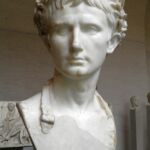Roman salute used in recent history (especially among national movements) is, according to many, derived from ancient Rome. However, we do not have any descriptions of this gesture in Roman literature or in the works of historians. Moreover, the Roman salute had little to do with the current symbolism of gesture.
This gesture is probably associated with the solar cult. By extending the hand up, homage was paid to the sun god.
In Rome, the right hand (called dextera or dextra) was usually used as a symbol of trust, friendship and loyalty or as a mere greeting (an empty hand was supposed to be proof that you don’t have a gun). For example, Cicero mentions that Octavian was swearing allegiance to his adopted father to Julius Caesar with his right hand outstretched. We do not know whether Octavian’s specific gesture already had its roots in tradition or whether it was Octavian’s private invention during his contio. Certain, however, is the unflattering assessment of the person of Gaius Octavian by Cicero.
Buildings (e.g., Arch of Titus, Arch of Constantine I, Trajan’s Column) commemorating the Roman military victories are the best-known examples showing the Roman salute. The bas-reliefs on these monuments do not show a single, clear illustration of this gesture. For example, three such images were analyzed in Trajan’s Column. On “Table 99” six spectators raise their right hands up (half straight, half bent at the elbow) in honour of Trajan. Only one of these people has an open palm facing up. Others, three people with their arms folded, have their thumbs down. In “Table 167” three defeated Dacians stretch their hands towards the emperor with outstretched fingers. In “Tables 122-123” the emperor on horseback is greeted by a squad of legionaries. None of the 15 soldiers spread their entire arms.
We have a record from Josephus, about soldiers saluting their commanders:
Each morning the legionaries go to their centurion and salute him. The centurions then go to the tribunes and salute them. All the tribunes then go to salute the general. He gives them the day’s watchword and other orders which they relay back to the men under their command.
– Flavius, Jewish War, III.5.3
Nowadays, both movement leaders and listeners perform salutes. In Rome (based on preserved images), usually, rulers or important personalities make the gesture. This sign was a symbol of power, although it sometimes also meant greeting and kindness. Four forms of gesture or behaviour were used in Rome:
- adlocutio – greeting the leader (usually the emperor) to his army and soldiers to the leader;
- acclamatio – a public sign of approval or disapproval, contentment or dissatisfaction etc., in the form of shouts. Depending on the event, various slogans were shouted: during the wedding Io Hymen, Hymenaee or Talassio; on triumphs Io triumphe, Io triumphe; in turn speakers were awarded the terms Bene et praeclare, Belle et festive, Non potest melius;
- adventus – the ceremony of welcoming the emperor to the city (usually Rome) either during the ongoing conflict or after its end;
- profectio – a farewell ceremony when leaving the city of consul (republic) or emperor (imperial times).
An example of the Roman salute as a symbol of imperial power is the statue “Augustus of Prima Porta”.








